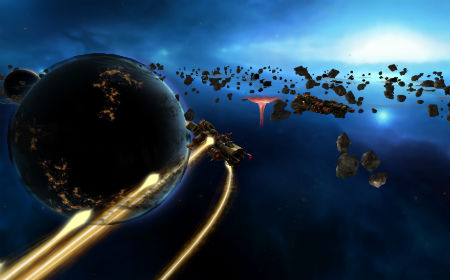Starships is a fantastic light strategy game, and a worthy winner of the Gold Award we bestowed on it. One of its few weaknesses is the fact that the brief tutorial leaves out lots of essential information.
It's enough to play on the easy difficulty setting, but if you want to ramp up the challenge, you'll need to know more.
We've put together this handy strategy guide to help you out. The first thing you should do, however, is do what the game suggests and read the space-o-pedia. It's not the most well-organised document, but it does cover most of what you need to know about the game mechanics.
For starters, it tells you that the different resources you gather during the game - energy, metals, science, and food - are spent on different things. Energy is for upgrading and repairing starships. Metal builds wonders or upgrades, food builds cities, and science builds technologies.
Since they're all separate pools, there's no reason not to spend all of them every turn. Although it can be wise to keep a little energy in the pot in case you need to repair damage between missions.
Starting outWhen you're starting a new game, you get to choose several parameters about the galaxy you're going to be competing for.
One oft-overlooked combination is number of opponents and map size. The more people you pack into a small space, the more difficult it'll be to secure your foothold. So changing these options can be a useful way of increasing or decreasing the challenge of the game.
The more substantive choices involve faction and leader. For the former, the Purity do seem the obvious choice. Those bonus rewards are a huge boon early on and keep on paying into the mid-game.
The Supremacy come a close second. A free wonder can be a huge initial boost, but it depends which one you get, and it's chosen at random. The Harmony trail a distant third with a power that's useful only when ships get damaged.

Picking leaders is much less clear-cut. Most of them are useful, and most have abilities that tie in particularly well with certain victory conditions.
Kozlov, for instance, produces extra metals and that's the prime resource for making wonders. Pick him for the Supremacy and you'll gain a big head start toward a wonder victory.
Bolivar and Hutama are both conquest leaders. The extra starship the former offers is very useful in early engagements. The additional influence gained by the latter is a smaller but longer-lasting power.
Barre is the final potential choice for a top leader. He allows you to build cheap cities, which gives you more resources long run and lets you go for a population victory.
But if you pick him, remember to actually build plenty of settlements to gain best use of his bonus.
Galactic WondersWonders are pivotal to securing the galaxy. Not only does each give you a helpful special power, but build seven and you'll win an instant victory.
The galaxy does not create all wonders equal, however. Some are much more useful than others. So it's a bit of a shame you can't just pick whatever wonder you want. You have to own a planet capable of building that wonder first.
Still, you should accumulate plenty of options as you take control of sectors. Always be sure to check a newly-conquered system to see if you can build a wonder there. Here are the most useful picks - if you gain a planet with one of these, build it as early as possible.
If you use fighters, then Hyperlaunch is very powerful. It allows you to move a fighter group up to its full move on launch. Given the speed of these little craft, that gives you an enormous range. And unlike most attacks, you can often get around to the rear of the target right away for maximum damage.

Another useful offensive wonder is Convergent Light, which adds range to laser weapons. This allows you to take on the enemy at a greater distance. If you pump up the lasers of your craft, you can often destroy them before they even get in range.
There are several useful defensive wonders. Intelli Shields gives you protection all round the sides and rear as well as the front. If you boost the shields on your ships, this can leave them almost invulnerable.
Redundant Systems allows ships to automatically repair damage during battle which not only keeps you in the fight longer, but will pay for itself in the long run
In terms of general utility wonders, Dual Command is top of the pick list. It lets your ships take an action and fire a weapon each turn. This is the end of ship specialisation - with Dual Command every unit can be a fighter platform, or a torpedo boat, or a scout, as well as dealing damage to the enemy.
Space StrategyHowever good your empire management skills are, you'll win (or lose) the game on the tactical maps for each mission. The best course of action depends on the objective and the enemy forces, but here's a few generic pointers.
First, be aware of the battle cards at your disposal. You get one at the start of a battle, plus one for each Dark Matter sector you go through.
They're not mentioned in the tutorial and are easy to overlook. They appear as icons in the bottom left of the screen - hold your finger on one to find out what it does. All offer significant benefits if used at the right time.

The most effective combat options are lasers and fighters. Good laser strength means you can often take out the enemy before they get close enough to attack.
Fighters are super fast and hit hard. Not only can they get in valuable rear shots with ease, but they're also good for securing territory on missions that require it.
Torpedos can do a lot of damage, but the fact they take at least a turn to detonate makes them hard to aim properly. Plasma cannons are useful when you get up close and personal, but it's best to let fighters do that, and keep your precious flagships at a distance.









 How to be Mr Ruthless in Contract Killer 2: hints, tips, and tricks
How to be Mr Ruthless in Contract Killer 2: hints, tips, and tricks Bug Village Hack for Coins, Acorns & XP - AppGameCheats.com
Bug Village Hack for Coins, Acorns & XP - AppGameCheats.com Rayman Adventures Cheats: 6 Tips and Strategy Guide
Rayman Adventures Cheats: 6 Tips and Strategy Guide What’s that Phrase? Answers Level 61-80
What’s that Phrase? Answers Level 61-80 Quote Quiz – All Level Answers
Quote Quiz – All Level Answers